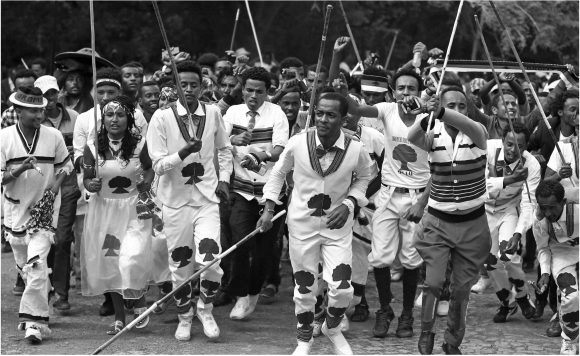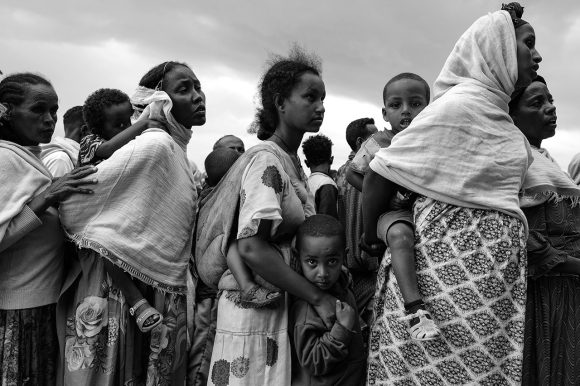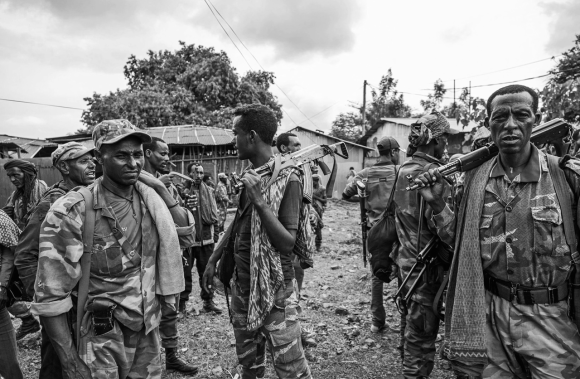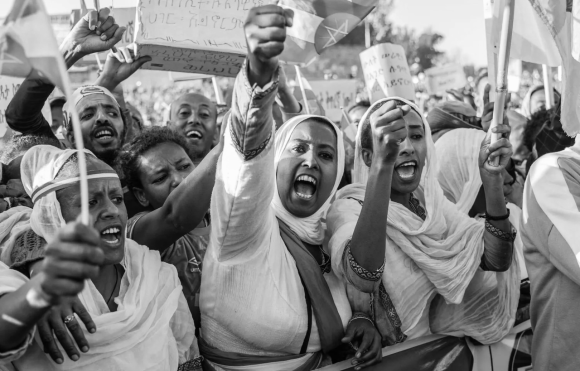A Personal Essay by Allison Bostrom
You could be forgiven for assuming that this article would focus on Tigray. Since civil war broke out in Ethiopia’s north in 2021, international attention has rightly focused on the conflict, which led to horrific civilian casualties and pushed the region to the brink of famine. Even after a peace agreement was reached in November, the Tigray region has remained an object of scrutiny. However, long before war broke out in Tigray, another human rights and humanitarian crisis threatened the people of Ethiopia. In Oromia, a large central region that includes the capital of Addis Ababa, protesters have been begging the government for relief and change for decades, as its residents have long suffered abuses.
Despite being the most populous ethnic group in Ethiopia, the Oromo people are systematically underrepresented in government, excluded from social and economic gains and disproportionately affected by poverty. Recently, their situation has become even more precarious as a more than three-year drought has decimated crops and livestock, the primary sources of income for the largely pastoral and agricultural region. Historically subjected to colonialism and ethnicity-based oppression, which is now compounded by climate disasters, the Oromo are symbols of inequality in modern times. However, their plight is almost never reported on by international media, and visiting dignitaries tend not to focus on the systematic human rights abuses taking place in the region.

Why is it that I, proud wielder of a Masters in International Development and avid consumer of human rights-related media, had never heard of the largest ethnic group in Ethiopia until just last year? To truly understand current events in Oromia and their relationship to global affairs, it is necessary to first review the history of the region and its people.
Oromo History
The Oromo are indigenous to the land that bears their name, as well as some northern regions in neighboring Kenya. Long before Oromia was subsumed into Ethiopia, its inhabitants had built a strong sense of shared identity underpinned by a democratic system of governance, language, and system of religious and cultural practices called the Gadaa system. Like any indigenous group, the Oromo have a sense of pride regarding their identity and the land on which they live. Thus, when the Abyssinian Empire attempted to conquer the Oromo, they failed for more than a century. What finally turned the tide in favor of the empire was the introduction of European weaponry and assistance.
Although Ethiopia is well-known as the only African country not to have been colonized by Europeans, it did not exist outside the European sphere of influence. The Abyssinians saw in the Europeans a chance to ally themselves with powerful global forces under the pretext of religion. The Europeans, in turn, likely viewed Abyssinia as a Christian empire attempting to bring the “uncivilized” under their control. They made arms deals with the Abyssinians, which gave the empire the means to finally conquer the Oromo and other southern nations. Over the next century, Oromia was used as a breadbasket to build the empire, while its norms and ways of life were belittled and their language banned. Its traditional inhabitants were pushed from their lands and livelihoods by mostly Amhara settlers.
From there, Oromo history follows a sadly familiar historical playbook. Despite their numbers, the Oromo have been largely excluded from participation in government. Their customary land use system has been ignored in favor of formal tenure processes that preclude them from practicing traditional livelihoods. Ruling elites spent decades instilling a sense of shame around the Oromo identity and restricted the use of Afaan Oromoo, the native language of the region, and Oromo cultural practices. These means of control will be familiar to any student of colonial history.

By the 1960s, the Oromo people had almost lost their sense of pride and identity. Recognizing these challenges, a group of Oromos founded the Macha-Tulama Self-Help Association, designed to organize the Oromo people in a group effort against poverty. Despite its innocuous purpose, it took months for the group to be certified by the government. However, once it was started, it ignited a flame in the Oromo people.
Macha-Tulama rapidly grew into a country-wide political movement. Renewed Oromo pride led to protest movements calling for a multi-ethnic government and cultural freedoms, including linguistic and religious freedoms. The rise of the Oromo inspired resistance across other oppressed ethnic groups as well, including the famous Bale peasant rebellion. The government, largely composed of ethnic Amharas, brutally repressed such uprisings. It ultimately imprisoned the leaders of Macha-Tulama and had some of them tortured and executed. However, it was too late to stop the movement they had sparked.
The Oromo reclaimed their language and their sense of identity and have not let go since. They now have the right to learn and converse in Afaan Oromoo, and to write it using Qubee, a Latin script which represents the sounds of the language properly. These hard-won gains have not led to equity yet, but Oromos continue to fight for their rights and dignity. Oromos have been protesting their subjugation since the Abyssinian conquest, with a renewed wave of protests in 2014, and again in 2020 following the death of popular Oromo musician Hachalu Hundessa. Now that they have reclaimed their language and identity, Oromos seek political power so they can prevent future abuses.
The Oromo Today
Despite the progress the Oromo have made toward full recognition of their rights, they continue to suffer human rights abuses, including killings, at the hands of the government, regional militias, and other armed groups. As before, the goal of these attacks appears to be to intimidate the Oromo and to suppress their identity and political movements.
A particularly gruesome video from last year is just one example that depicts decapitated Oromos whom the Amhara militia (Fano) members beheaded, without evidence of any wrongdoing. Such attacks have increased over the last year, possibly because the Amhara militia suspected the government may enter into a peace deal, as they did with Tigray. On the other hand, regional security forces have also increased their attacks against anyone they suspect to be members or supporters of the Oromo Liberation Army (OLA). Such attacks may be accompanied by forced confessions, as was the case in the extrajudicial killing of 17-year-old Amanuel Wondimu Kebede. At other times, no clear justification has been given for the abuse of Oromos. For example, hundreds of peacefully protesting students were forced to march barefoot over gravel following their detention in 2004. Massacres of civilians are horrifyingly commonplace, and sometimes the victims are from other ethnic groups who happen to live in Oromia, including Amhara.
It can be difficult to confidently identify the perpetrators of these attacks due to intermittent internet coverage and the lack of a robust independent investigation architecture. In light of the violence, Oromo activists and politicians have called for the Ethiopian government to enter into a peace agreement with the OLA like the one signed with the Tigrayans. This is necessary in order to ensure the safety and dignity of all citizens of Ethiopia, regardless of their ethnicity or the region in which they live. Recent attempts toward a peace agreement had an inauspicious start, with continued conflict between the OLA and government forces.

The violence and fear inflicted on the Oromo have been compounded in recent years by a severe drought. Five failed rainy seasons are threatening the livelihoods of millions of people and have led to the deaths of over four million livestock in Oromia alone, devastating an area that relies heavily on pastoralism. International aid has fallen short of what the UN estimates is needed, and concerning allegations of corruption have dogged food aid deliveries. In addition to rising food insecurity, Oromia is facing a cholera outbreak. Despite concerns about the inadequacy of current attempts to alleviate the dire health threats in Oromia, the regional government often claims its efforts are sufficient or denies the humanitarian crisis in Oromia. The UN disagrees, citing tens of thousands of cases of severe acute malnutrition. It is important to note that the regional government often uses security as pretext to hinder access to most parts of Oromia from humanitarian and media.
Why Don't We Know About All This?
This brings me back to my original question: why hadn’t I heard about the Oromo before? Why hadn’t anyone else? These events carry significance for the broader global community, not just Ethiopia. When imperialism and injustice are left unchecked, it emboldens others to emulate the behavior. However, the international community can only apply pressure if it is aware of these issues, and that is the job of news media outlets, the United Nations, and state departments.
The problem is not simply that Oromia doesn’t make headlines, it’s that it barely exists in English language media at all. It took me, a relatively experienced researcher, weeks of searching and digging just to learn enough to feel confident writing this article. Human Rights Watch and The New Humanitarian have written about the deteriorating conditions in Oromia, but otherwise, there is scant information to be found. Most of what is available is in journal articles or old books, not the sort of material most people would come across without concerted effort (and, often, an institutional login for a journal or database).

I myself only became aware of this crisis because I began volunteering for the organization OLLAA (Oromo Legacy Leadership and Advocacy Association), formed by members of the Oromo diaspora in the US. I am writing this article with their support and encouragement because the Oromo people have tried to draw the attention of the international news media to their plight, but they have often been met with skepticism. Rather than seeing the lack of reporting as a major problem, members of the media have instead seemed wary about the credibility of the information they hear. This, of course, becomes a vicious cycle; if no one writes about an issue, then isolated reports of human rights abuses are regarded as lacking independent verification, which means no one writes about them. This is why investigative journalism as a field exists – it is the means by which news outlets verify reports from the ground. Selective coverage can have real-world consequences, validating the experiences of some while glossing over others.

